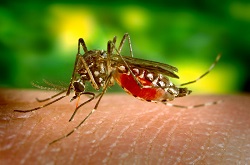By Andrea Grenadier, Communications Specialist, NACCHO
 Representatives from major public health organizations addressed attendees at the 2016 Preparedness Summit in a late-breaking session that succinctly addressed the threats of Zika virus disease, as well as the latest scientific information and front-line response activities from both states and the federal government.
Representatives from major public health organizations addressed attendees at the 2016 Preparedness Summit in a late-breaking session that succinctly addressed the threats of Zika virus disease, as well as the latest scientific information and front-line response activities from both states and the federal government.
The numbers growing daily show the sheer breadth of the disease: There could be up to four million cases this year, just eight months after the first case was reported in Brazil. There are 30 countries with active virus transmission. As of April 13, the CDC reports that there were 358 confirmed cases of travel-associated Zika virus disease in the United States.
The speakers—representing state health departments, the Association of Public Health Laboratories (APHL), and federal agencies including the Centers for Disease Control and Prevention (CDC), the Food and Drug Administration (FDA), and the U.S. Department of Health and Human Services (HHS)—brought a wealth of expertise and urgency to the meeting, discussing diagnostics, efforts to address at-risk populations, risk communications, surveillance, and vector control.
The experts brought a much-needed perspective to understanding the Zika virus disease. Christine Kosmos, CDC, said, “We didn’t even have time to deactivate after Ebola before we had to deal with Zika; we haven’t seen a virus that causes birth defects since measles.” She presented the CDC’s current response actions, including surveillance, laboratory testing and diagnostics, and vector surveillance and control, noting that “no supplemental funding has been given to CDC, but the one thing I talked to our prep directors about is that if we learned a lesson from Ebola, it was that the speed and the scale in which you can response to a public health emergency has a lot to do with the trajectory of the illness, and how you can impact that trajectory.”
CDC’s response actions include a phased risk-based plan for states; vector control, and communication planning. “Zika could explode through the Americas and spread to the U.S., and these could be devastating and lifelong,” Ms. Kosmos said.
Dr. Sally Philips noted that, “HHS is taking a very proactive stance, using a strategy of requiring better diagnostics, getting guidance and communications into the hands of healthcare providers, vector control, identifying parties to create capacity and service, screening blood, ensuring case management, and ascertaining lab capacity.”
Dr. John Hellerstedt, commissioner of the Texas Department of State Health Services, said, “our planning isn’t ‘if’; it’s ‘when,’ and we hope we can do everything we can with vector control agencies to postpone or prevent [widespread Zika infections] from happening.” He shared some of the challenges specific to Texas are a lack of statewide surveillance system, so cities and counties are responsible for the first type of response needed.
Brooke Courtney from the Office of Counterterrorism and Emerging Threats spoke about the FDA’s is engagement in blood safety, clinical diagnostic tests, vaccine development, vector control, and monitoring for fraudulent products. Currently, no FDA-approved, -licensed, or –cleared medical products are available to prevent, treat, or diagnose Zika virus. The FDA is also exploring genetically engineered mosquitos and reviewing proposals for innovative vector control strategies — this may cut down on the mosquito population, but not the disease.
The Association of Public Health Laboratories’ Scott Becker shared the lab response to the crisis, noting that ongoing needs and challenges require money. APHL has been engaged in a highly rigorous response in incident management driven by science with the goal of supporting public health labs; offering technical assistance; conducting assessments to understand capability and capacity; creating partnerships; engaging in public policy with briefings for key congressional staff and regulatory discussions with the FDA; and responding to media requests to explain the role of public health labs and capabilities.
“We can’t spray our way out of this,” said Umair Shah, MD, MPH executive director of Harris County Public Health and Environmental Services (Houston), as he gave the local perspective, discussed Texas’ highly diverse population, and added that “what we do together really matters.”
Texas and Harris County have a multidisciplinary approach: understanding the Aedes vector in the region; recognizing the need to shift from a primarily Culex-based program to incorporate Aedes as a targeted vector; appreciate the importance of public education and personal protection; and assuring that the health equity lens is involved to the evolving multidisciplinary response. Harris County is:
- Engaged in mosquito surveillance using historical data on Aedes combined with expanded surveillance, including predictive modeling within 268 operational areas;
- Generating GIS maps indicating key metrics, such as mosquito population density levels of Aedes, Zika-confirmed mosquito samples, local cases of human infections, and sources of breeding;
- Conducting necessary staff training for inspectors, larvicide applicators, and other support personnel;
- Acquiring testing materials and lab equipment for mosquito virology lab for Zika; and
- Working with partners and community members on key issues around reducing mosquito habitats.
NACCHO compiled a list of relevant Zika resources for local health departments. Learn more.








